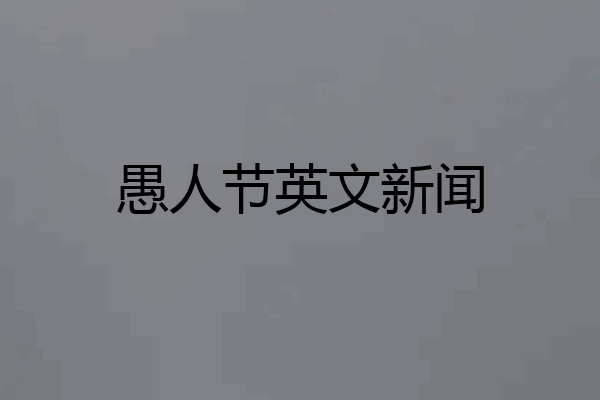 自由的红枫叶
自由的红枫叶
共5条回答322浏览
-
-

愚人节中学生捉弄人的英语小故事
每年的4月1日为愚人节,关于愚人节的英语小故事有哪些呢?下面是我整理的愚人节中学生捉弄人的英语小故事,欢迎阅读。
Alabama Changes the Value of Pi
圆周率值的修改
1998: The April 1998 issue of the New Mexicans for Scienceand Reason newsletter contained an article claiming that the Alabama statelegislature had voted to change the value of the mathematical constant pi from3.14159 to the 'Biblical value' of 3.0. Soon the article made its way onto theinternet, and then it rapidly spread around the world, forwarded by email. Itonly became apparent how far the article had spread when the Alabama legislature began receiving hundredsof calls from people protesting the legislation. The original article, whichwas intended as a parody of legislative attempts to circumscribe the teachingof evolution, was written by physicist Mark Boslough。
1998年愚人节:New Mexicans科学技术杂志宣称阿拉巴马州要立法改变圆周率pi的值,很快这事被传上网,通过电子邮件传遍全世界。阿拉巴马立法机构因此接到无数抗议电话。
The Taco Liberty Bell
塔可自由钟
Taco Liberty Bell1996: The Taco Bell Corporation announced it had bought the Liberty Bell and was renaming it the Taco Liberty Bell. Hundreds of outraged citizens called the National Historic Park in Philadelphia where the bell was housed to express their anger. Their nerves were only calmed when Taco Bell revealed, a few hours later, that it was all a practical joke. The best line of the day came when White House press secretary Mike McCurry was asked about the sale. Thinking on his feet, he responded that the Lincoln Memorial had also been sold. It would now be known, he said, as the Ford Lincoln Mercury Memorial。
1996年愚人节,塔可钟快餐公司说他们买下了美国费城独立厅的大钟,并重命名为塔可自由钟。愤怒的'市民打电话给费城的国家历史公园,要求确认这个消息。几小时后塔可钟快餐公司承认这只是个玩笑。当天最乌龙的事件还不在此。白宫记者会秘书Mike McCurry被问到这件事时,随机应变回答说,林肯纪念碑也被卖了,现在被命名为福特水星汽车纪念碑。
The Swiss Spaghetti Harvest
瑞士面条树
Spaghetti harvest1957: The respected BBC news show Panoramaannounced that thanks to a very mild winter and the virtual elimination of thedreaded spaghetti weevil, Swiss farmers were enjoying a bumper spaghetti crop.It accompanied this announcement with footage of Swiss peasants pulling strandsof spaghetti down from trees. Huge numbers of viewers were taken in. Manycalled the BBC wanting to know how they could grow their own spaghetti tree. Tothis the BBC diplomatically replied, "place a sprig of spaghetti in a tinof tomato sauce and hope for the best."
1957年愚人节BBC新闻中说,瑞士的面条树大丰收,农民都在树上收割面条。大量观众上当受骗,打电话来咨询面条树的种植方法。BBC对此的回复是:把一根面条插在番茄酱里,然后就等着吧。
-
-
-
据说,愚人节起源于一个很有名的希腊神话传说。 农业女神得墨忒尔,在希腊是个妇孺皆知的神祗。她具有无边的法力,可以使土地肥沃,五谷丰登,也可以令田园荒芜,万物凋零。在希腊众神中,她也是最受尊崇的女神之一。万神之王宙斯是她的弟弟,也是她的丈夫。仅仅这个身份,就足以使众神在她的脚下俯首帖耳了。但是,这位权势无比的女神的生活并非十全十美。宙斯凭借着神王的地位,到处拈花惹草,闹出了许多风流韵事,给得墨忒尔带来了无穷无尽的烦恼。唯一能够让她享受生活乐趣的,还是她和宙斯生的女儿佩尔塞福涅,一个聪慧、美丽、天真、活泼的姑娘,和她在一起,任何人都不会悲伤和忧愁。 这一天,冥王哈得斯驾车巡视西西里岛,恰好被在云端中走过的爱与美女神阿芙罗狄忒看到了,同时让她看到的,还有正在田野里散步的佩尔塞福涅,以及她的伙伴女战神雅典娜,狩猎女神阿尔忒弥斯。一看到这几个人,阿芙罗狄忒就气不打一处来。这几个男女,从来不议论爱情,也不谈婚论嫁,眼睛里可还有她爱神的地位吗?雅典娜和阿尔忒弥斯是出名的贞洁女神,又都以武艺高强,神通广大,闻名神界天国,还是不惹为好。但对佩尔塞福涅这小丫头,可就不必客气了。于是,头上晃动着神圣光环的阿芙洛蒂德唤过自己的儿子小爱神厄罗斯,对他说:"看看吧,这几个人是怎洋对待爱情的?如果人和神都学他们的样,我们还怎样统治这个世界?来,给哈得斯射上一箭,让他疯狂地爱上佩尔塞福涅!" 厄罗斯是个百发百中的神射手。他弯弓劲射,一技无形的情欲之箭,正扎进哈得斯的心窝。然后,他便跟随着阿芙洛蒂德,扬长而去,静等着看好戏了。果然,哈得斯中箭后,对佩尔塞福涅产生了刻骨铭心的爱。但他明白得很,这个远近闻名的美人儿,绝不会情愿放弃阳光明媚的大地和天空,跟他到阴暗的冥府中去。因此,他找到自己的兄弟众神之王宙斯,请求他作主将女儿嫁到冥府。"这个么……我作不了主",众神的主宰沉思着说,"你也知道,得墨忒尔难缠得很。不过,你要是有本事把佩尔塞福涅抢走,我倒不反对。"得到了神王的默许和暗示,哈得斯满心欢喜,他立刻返回冥土,做好抢亲的准备。 一天,佩尔塞福涅在田野里正欲弯腰采摘一朵野花时,大地突然裂开了一条宽宽的地缝。随后,一辆闪闪发光的金车,冲上了地面,驾车的就是威风凛凛的冥王。他不由分说,一把抱起佩尔塞福涅,放到他身边的座位上,一声吆喝,马车便以迅不可及的速度沉入地下。裂开的大地倏然合上了,依然是阳光灿烂,绿草如茵,除了天空中还回荡着佩尔塞福涅的呼救声外,好像什么也没发生过。得墨忒尔在很遥远的地方,听到了女儿撕心裂肺般的呼救声。但当她以最快的速度飞回来时,女儿已经不见了。她只知道女儿被"强盗"劫走了,但是,这个强盗是谁,却一点蛛丝马迹也寻不出来。那些知道佩尔塞福涅下落的神灵们,全都缄口不言。他们知道这件事的背景,宙斯和哈得斯都不是好惹的,谁也不想引火烧身。有几个神祗被逼问急了,也是东西南北瞎扯一通。女神按照他们的指点,没头苍蝇般乱闯乱撞,不用说,这些都成了徒劳无功的跋涉。 然而,对女儿的爱,促使得墨忒尔永无休止地找下去。无论哪个神说了什么,她都确信不疑。虽然后来的事实证明,那些都是彻头彻尾的谎言。无奈之下,她在深不可测的埃特纳火山口点燃了两支松木火把,把整个世界照得一片通明。从那时起,无论黎明女神还是黑夜女神,都未见她坐下来休息片刻。就这样,得墨忒尔走遍了世界上的每一个角落。但是,她的女儿就像被风卷走了,被太阳晒化了,或者变成了水汽和浮云似的,仍然踪影全无。众神对她也逐渐由同情转为厌恶。因为这个"女疯子"为寻找女儿,搅得世界上没有片刻安宁。他们越加拿她开起心来,忽而指向东南,忽而指向西北,无非是想把她支走,过几天太平日子。 最后,得墨忒尔只得拖着疲倦的身子,返回了西西里岛,佩尔塞福涅失踪的地方。奔波了这许多天,连罪魁祸首是谁都不知道,女神的气恼可想而知。于是,她便把一肚子的怨气,都撒到了西西里农人身上。她杀死了岛上所有的耕牛,命令土地坚如钢铁,封住地里的种子,让所有的植物都枯黄凋零。把这个地域辽阔的大岛弄得赤地千里,饿殍遍地。宙斯见她闹得太不像话,就"好心"地劝她再到别处看看,别拿无辜的农民出气。得墨忒尔不知其中有诈,再一次踏上了东西逛的征途。这一下了可不得了,不知多少地方,由于女神的愤怒,变得颗粒无收,到处都弥漫着饥馑和灾荒的绝望气氛。 当她明白自己又上了丈夫一个大当时,才静下心来,想一想到底该怎洋办,无意中她抬起头来,看到了驾着金车,在茫茫太空巡行的太阳神赫利俄斯。猛然想到,只有他高高在上,普照一切,明察秋毫,天底下发生的任何事情,都不可能逃过他的双眼。这才手执火把,飞到赫利俄斯面前,请他指点迷津。 伟大的太阳神怜悯女神的遭遇,又无需畏惧冥王的权势。而且,他也不愿意得墨忒尔再这样大闹下去,让众神看笑话,让老百姓受难,便把哈得斯抢亲的情况,仔细描述了一番。得墨忒尔恍然大悟,但为时已晚。此时此刻,佩尔塞福涅在哈得斯的威逼利诱下,已然成了尊贵的冥后,无法再到地上和母亲团聚了。何况,得墨忒尔再神通广大,也没本事把女儿从哈得斯手中硬夺过来。 得墨忒尔知道自己受了众神的欺骗、愚弄,愤懑和气恼又加深了一层。她干脆下了一道命令,让全世界的植物一起凋零,所有的庄稼全部枯死,大地上不允许出现一丝绿色。自己则躲到一个偏僻的地方,不再露面。这一来,天上地下全部乱了套。老百姓没有粮食吃,每天都有成千上万人饿死。成群结队的亡魂拥入冥府,吵吵闹闹,把哈得斯弄得心烦意乱,狼狈不堪。众神也因为得不到人间的祭祀和礼物,一个个饿得面黄肌瘦。宙斯没办法,只好让佩尔塞福涅每年有1/3时间住在冥府,2/3时间则返回人世,侍奉她的母亲。以后,每当佩尔塞福涅留居冥土时,得墨忒尔便愁眉不展,大地也是一片萧条。而女儿一旦和她团聚,女神便喜笑颜开,世界也重现草木复苏,群芳争艳的勃勃生机。 很明显,在这个故事里,得墨忒尔是一个十足的傻瓜。她不知道爱神的把戏,不知道丈夫和哈得斯的同谋,事件发生后,又被众神支得团团转,屡屡受骗上当,被人戏弄。此后,人们便设立了愚人节,用善意的谎言,告诫那些自以为聪明的人,不要由于轻信,干出贻笑大方的蠢事。
-
-
-
The origin of April fool's day
愚人节的来历
April Fool's Day is traditionally a day to play practical jokes on others, send people on fool's errands, and fool the unsuspecting. No one knows how this holiday began but it was thought to have originated in France.
传统上来讲,愚人节这一天,人们可以相互搞恶作剧,骗人跑腿,欺骗不知情的人。没人知道这个节日是怎么来的,但人们普遍认为它源自法国。
The closest point in time that can be identified as the beginning of this tradition was in 1582, in France. New Year's was celebrated on March 25 and celebrations lasted until April 1st. When New Year's Day as changed from March 25 to January 1st in the mid-1560's by King Charles IX, there were some people who still celebrated it on April 1st and those people were called April Fools.
庆祝愚人节最早是在1582年,在法国。那时,当时法国新年是在3月25日,一直持续到4月1日。16世纪60年代中期,国王查理九世把新年从3月25日变为1月1日,而还有一些人在4月1日过新年,这些人就被称作四月傻瓜了。
Pranks performed on April Fool's Day range from the simple, (such as saying, "Your shoe's untied!), to the elaborate.
Setting a roommate's alarm clock back an hour is a common gag. The news media even gets involved. For instance, a British short film once shown on April Fool's Day was a fairly detailed documentary about "spaghetti farmers" and how they harvest their crop from the spaghetti trees. Whatever the prank, the trickster usually ends it by yelling to his victim, "April Fool!"
愚人节那天的恶作剧有的很简单(比如,说句“你鞋带开了!”),有的却是精心设计的。把室友的闹钟往后调一小时是常见的。甚至新闻媒体都来凑热闹。
比如,在愚人节那天,曾经有一部英国短片较为详细地记录了“种意大利面的农民”,以及他们如何从意大利面树上收获意大利面。不管是什么恶作剧,搞恶作剧的人通常在最后会对被搞的人喊一句:"四月傻瓜!"
April Fool's Day is a "for-fun-only" observance. Nobody is expected to buy gifts or to take their "significant other" out to eat in a fancy restaurant. Nobody gets off work or school. It's simply a fun little holiday, but a holiday on which one must remain forever vigilant, for he may be the next April Fool!
愚人节是一个“仅为娱乐”的节日。谁也不用买礼物,也不用带着男/女朋友出去到一家豪华餐厅去吃饭。人们也不会放假。它仅仅是个搞笑的小节日,但是在这一天,每个人都要保持警醒,不然就要被人耍啦。
Each country celebrates April Fool's differently. In France, the April Fool's is called "April Fish" (Poisson d'Avril). The French fool their friends by taping a paper fish to their friends' backs and when some discovers this trick, they yell "Poisson d'Avril!".
扩展资料:
愚人节的习俗
1、鱼宴:
参加鱼宴的请帖,通常是用纸板做成的彩色小鱼。餐桌用绿、白两色装饰起来, 中间放上鱼缸和小巧玲珑的钓鱼竿,每个钓竿上系一条绿色飘带,挂着送给客人的礼物或是一个精巧的赛璐珞鱼,或是一个装满糖果的鱼篮子。不言而喻,鱼宴上所有的菜都是用鱼做成的。
2、做假菜:
在愚人节的聚会上,还有一种做假菜的风俗。有人曾经描述过一个典型的愚人节菜谱:
先是一道“色拉”,莴苣叶上撒满了绿胡椒,但是把叶子揭开后,才发现下面原来是牡蛎鸡尾酒;第二道菜是"烤土豆",其实下面是甜面包屑和鲜蘑;此后上的菜还有用蟹肉作伪装的烧鸡和埋藏在西红柿色拉下面的覆盆子冰淇淋。饭后,客人还可以从药丸盒里取食糖果。
3、互相开玩笑:
愚人节最典型的活动还是大家互相开玩笑,用假话捉弄对方。有的人把细线拴着的钱包丢在大街上,自己在暗处拉着线的另一端。一旦有人捡起钱包,他们就出其不意地猛然把钱包拽走。
还有人把砖头放在破帽子下面搁在马路当中,然后等着看谁来了会踢它。小孩们会告诉父母说自己的书包破了个洞,或者脸上有个黑点.等大人俯身来看时,他们就一边喊着"四月傻瓜"。一边笑着跑开去。
总之,每逢愚人节这一天,动物园和水族馆还会接到不少打给菲什 (鱼)先生泰歌(老虎)先生的电话,常常惹得工作人员掐断电话线,以便减少麻烦。
参考资料:百度百科-愚人节 (西方节日)
参考资料:人民网-愚人节的由来
-
-
-
According to British historians, according to the encyclopedia of the English, "April fool's day" is a lie festival that appeared after the religious revolution in the 15th century.
At that time, Philip ii, king of Spain, established a "heresy tribunal". Anyone who was not a Catholic was considered a heresy and was sentenced to death on April 1 every year.
The subjects were so frightened that they told lies and made fun of them every day to dilute their fear and hatred of the ruler. Since then, continue to use for a long time, evolved into today's "April fool's day".
译文:
据英国历史学家的考证:英人百科全书里面则是记载着:“愚人节”乃是公元十五世纪宗教革命之后始出现的一个说谎节日。
那时西班牙王腓力二世曾经建立一个“异端裁判所”,只要不是天主教徒就被视为异端,在每年四月一日处以极刑,也就是死刑。
臣民们感到非常恐怖,于是每天以说谎取笑为乐,来冲淡对统治者之恐惧与憎恨。其后,沿用日久,演变为今日之“愚人节”。
扩展资料:
愚人节的节日习俗:
愚人节时,人们常常组织家庭聚会,用水仙花和雏菊把房间装饰一新。典型的传统做法是布置假的环境,可以把房间布置得像过圣诞节一样.也可以布置得像过新年一样,待客人来时,则祝贺他们“圣诞快乐”或“新年快乐”,令人感到别致有趣。
四月一日的鱼宴。也是别开生面的。参加鱼宴的请帖,通常是用纸板做成的彩色小鱼。餐桌用绿、白两色装饰起来.中间放上鱼缸和小巧玲珑的钓鱼竿,每个钓竿上系一条绿色飘带,挂着送给客人的礼物或是一个精巧的赛璐珞鱼,或是一个装满糖果的鱼篮子。
在愚人节的聚会上,还有一种做假菜的风俗。有人曾经描述过一个典型的愚人节菜谱:先是一道“色拉”,莴苣叶上撒满了绿胡椒,但是把叶子揭开后,才发现下面原来是牡蛎鸡尾酒;
第二道菜是"烤土豆",其实下面是甜面包屑和鲜蘑;此后上的菜还有用蟹肉作伪装的烧鸡和埋藏在西红柿色拉下面的覆盆子冰淇淋。饭后,客人还可以从药丸盒里取食糖果。
不过愚人节最典型的活动还是大家互相开玩笑,用假话捉弄对方。有的人把细线拴着的钱包丢在大街上,自己在暗处拉着线的另一端。一旦有人捡起钱包,他们就出其不意地猛然把钱包拽走。还有人把砖头放在破帽子下面搁在马路当中,然后等着看谁来了会踢它。
小孩们会告诉父母说自己的书包破了个洞,或者脸上有个黑点.等大人俯身来看时,他们就一边喊着“四月傻瓜”。一边笑着跑开去。总之,每逢愚人节这一天,动物园和水族馆还会接到不少打给菲什(鱼)先生泰歌(老虎)先生的电话,常常惹得工作人员掐断电话线,以便减少麻烦。
-
-
-
尼克松复出,虚拟国家,塔可自由钟,分割比例时1992年,虚拟棒球天才,瑞士面条树,蒙娜丽莎的皱眉等,这些都是愚人节发生的事情。
-




